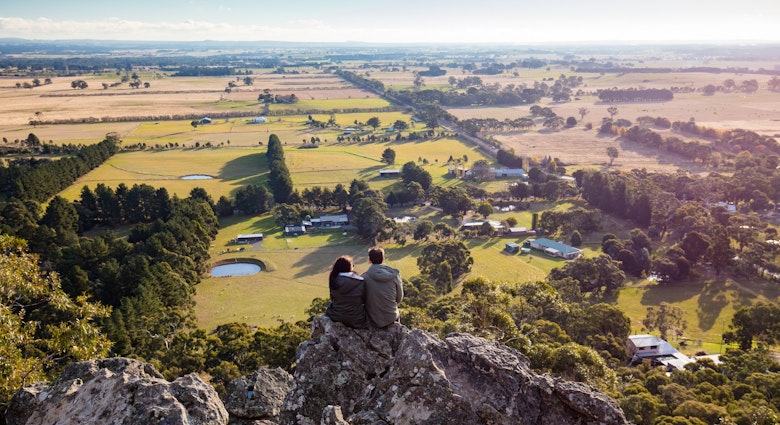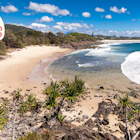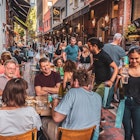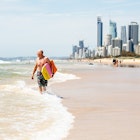As a progressive metropolis that regularly tops rankings of the world’s most livable cities, you might expect Melbourne to be a breeze to navigate – and you wouldn’t be wrong.
Although Greater Melbourne is a sprawl that can take hours to cross without a car, most major attractions are concentrated in the city center (also known as the central business district or CBD) and its surrounding neighborhoods.
This part of the city is well-serviced by public transportation, including the world’s longest tram network. These areas are also highly walkable and bikeable, a quality aided by relatively flat terrain and the availability of bike rentals. And for attractions further afield, trains, trams, buses and even boats carry you to them with ease.
To help you experience everything the city has to offer, here’s our guide to getting around in Melbourne.
Use a Myki card to get moving
To collect fares, Melbourne’s trains, trams and buses use Myki, a touch-on, touch-off system with card readers located aboard trams, buses and on train station platforms.
It’s the only way to pay for public transit and should be one of your first purchases on arrival. Standard Myki cards cost $6 and can be purchased and topped with credit at convenience stores and staffed train stations, or from dedicated vending machines at stations and major tram stops. There are also Myki vending machines within Terminals 2, 3 and 4 at the Melbourne Airport.
If you have an Android phone, you can use your phone to tap on and off using Myki via the Wallet app. An app for iPhone users does not yet exist.
The standard two-hour fare across Melbourne is $5, and there’s a daily fare cap of $10 on weekdays and $7.20 on weekends. You can either pay as you go from your credit balance or purchase a seven-day unlimited travel Myki Pass ($50).
Note that there are large fines for traveling without having touched on a valid Myki card, and ticket inspectors are unforgiving and sometimes undercover.
For timetables, maps and a journey planner, visit Public Transport Victoria (PTV). Handy transport planning apps include PTV, tramTRACKER and CityMapper.
Visitors also have the option of a Myki Explorer pack ($16), which includes the card, one day's travel credit and discounts on various attractions including several museums. It's available from SkyBus terminals, the PTV Hub at Southern Cross Station and some hotels.
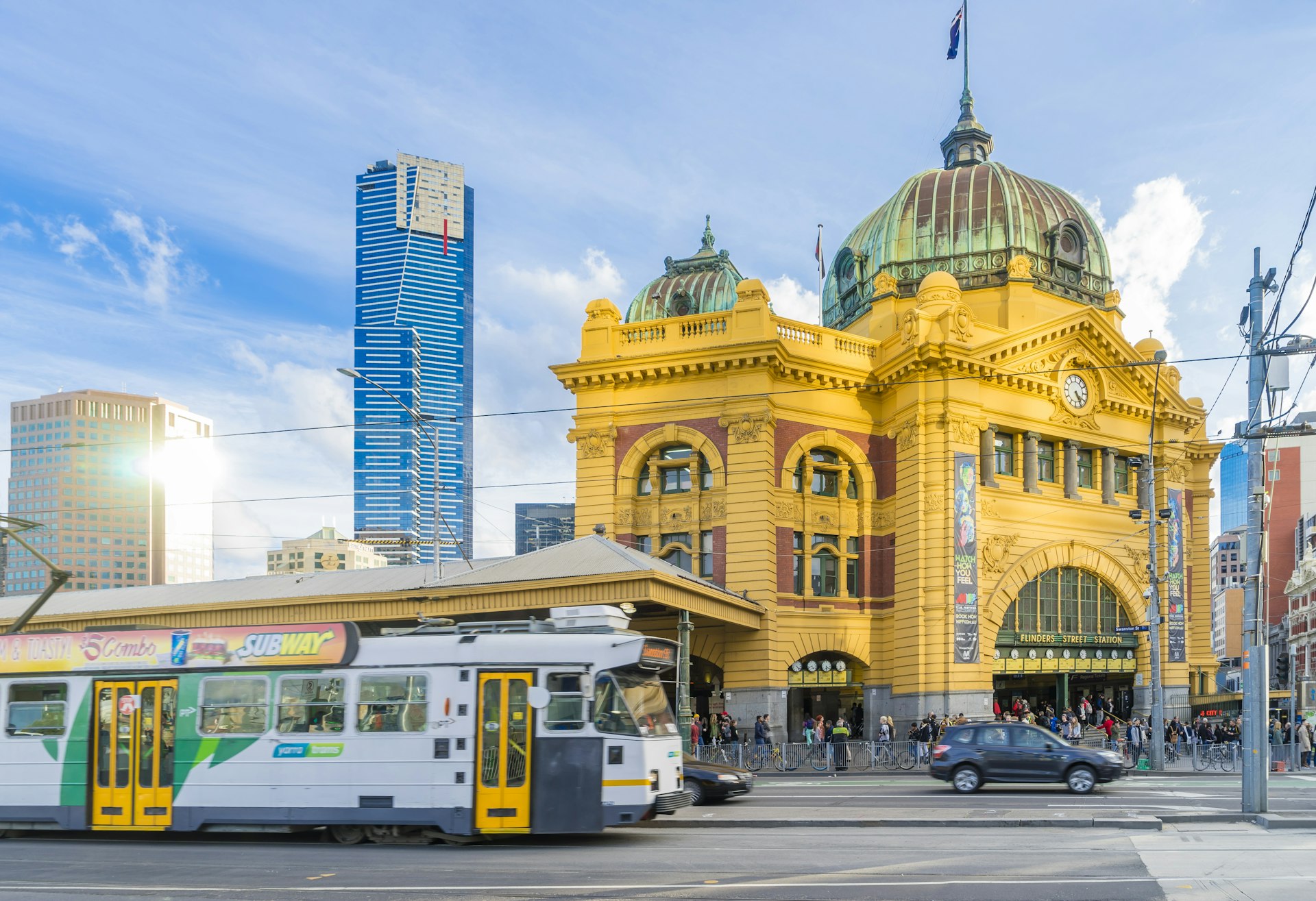
Catch an iconic tram through eclectic neighborhoods
Trams are both a practical means of transport and a quintessential Melbourne experience. They run roughly every 10 to 12 minutes during the day (more frequently in peak periods) and every 15 minutes in the evening. Services operate until around 12:30am Sunday to Thursday and 1am Friday and Saturday on most lines. A night service is also available (every 30 minutes) on Friday and Saturday on a handful of lines.
All aboard for a free introduction to the city center
Trams are free to ride within the Free Tram Zone in the city center. The zone is signposted on tram stops, with announcements made when you're nearing its edge.
One tram route entirely within the Free Tram Zone is the City Circle (route 35), on which delightfully retro W-class trams follow a clockwise circuit around the CBD and Docklands.
Ride the train network to speed across the city
Melbourne’s suburban trains are the fastest and most comfortable way to travel significant distances across the city. Flinders Street Station and Southern Cross Station are the main downtown hubs for Melbourne's 17 train lines, which radiate out to the suburbs.
Trains start operating around 5am on weekdays, run until after midnight Sunday to Thursday, and all night on Friday and Saturday nights. Trains generally run every 10 to 20 minutes during the day, every 20 to 30 minutes in the evening and more frequently during peak periods.
Use the bus – or night bus – to reach your destination
Melbourne has an extensive bus network, with over 300 routes covering places trains and trams don't go. Most routes run from 6am to 9pm on weekdays, 8am to 9pm on Saturdays, and 9am to 9pm on Sundays. Night Bus services operate after midnight on weekends to many suburbs. You need to hail buses as they approach your stop, so the driver knows you want to board.

Explore Melbourne’s parks and streets on two wheels
Melbourne is up there with the most cycle-friendly cities in Australia, with work ongoing to improve the infrastructure. Bikes can be rented from outlets including Blue Tongue Bikes, BikeNow and Port Melbourne Cycles. Though conventional bikes can be taken on trains (but not the first carriage), only folding bikes are allowed on trams or buses. Helmets are compulsory for cyclists.
Some of Melbourne's cycle paths head through lush parklands, beside shaded creeks and along rivers. Detailed cycle maps are available from the Melbourne Visitor Hub at the Melbourne Town Hall.
Since 2022, Melbourne has also been trialing an e-scooter share scheme in the city center and surrounding neighborhoods. Helmets must be worn while using e-scooters and they must be ridden on roads only. To zip around on one, download the Lime or Neuron apps.
Car rentals are best left to adventures further afield
Cars tend to be more of a hindrance than a help when exploring Melbourne, as parking is difficult to find and expensive (even at hotels) and roads are busy. You’ll also have to contend with trams sharing the street and the distinctive road rules that apply to them.
For example, there’s Melbourne’s infamous “hook turn,” in which cars wanting to turn right across a tram line must first pull over on the far left of the street, in order not to block trams. Unless you’re planning to drive into the countryside – such as along the Great Ocean Road – you might prefer to stick to public transportation. If you do decide to drive, see Vic Roads for further details on local road rules.
In Melbourne itself, most street parking is metered and parking inspectors are particularly vigilant in the city center and popular nearby suburbs such as St Kilda, Collingwood and Fitzroy. Motorcyclists are allowed to park on the sidewalk, except in some parts of the city center where there are signs.
Cars and campervans can be rented from companies such as Jucy, Avis, Hertz and Rent a Bomb (“bomb” being Aussie slang for an old car). Motorbike rental spots include Moto Sparta north of the city center and EagleRider Melbourne in eastern Ringwood.
Summon taxis and ride-hailing services if you're short on time
Melbourne’s taxis are metered and require an estimated prepaid fare when hailed between 10pm and 5am; one of the taxi ranks most likely to have a vehicle waiting is next to Flinders St Station on Swanston St.
Two of the largest taxi companies are Silver Top and 13 Cabs, both of which have booking apps. Several ride-hailing services also operate, such as Uber, DiDi, and Shebah, the latter of which features an all-female fleet of drivers offering rides for women and children.

Set sail to see Melbourne from the water
Though boats are a less-used form of transport, it’s a fun way to see the city and get around. Melbourne Water Taxis conveys clients along the Yarra and Maribyrnong Rivers, while other passenger boats link the Southbank promenade and Williamstown's Gem Pier several times a day. The charming Westgate Punt carries pedestrians and cyclists across the Yarra between Port Melbourne and Spotswood.
Accessible transportation in Melbourne
All trains and most buses are accessible by way of ramps. If using trains, you need to be at the front of the platform so the driver can see you and put the ramp out.
Trams are more hit-and-miss – many vehicles and stops are low-floor and wheelchair-accessible, but less so outside the CBD. The free tramTRACKER app displays a wheelchair icon to indicate approaching low-floor trams. The journey planner on the PTV website has a useful filter for wheelchair-accessible services and stops.
13 Cabs offers wheelchair-accessible taxis, but be aware that you may have to wait a long time, especially during peak hours and in the evenings.
Holders of current and valid interstate or overseas disability parking permits may park in reserved disability parking spaces for the specified time, and may also park in regular parking bays for twice the specified time upon payment of applicable parking fees (often waived for permit holders – see signs on parking meters for confirmation).
Elsewhere, sidewalks are generally in good repair and curb cuts are standard, as are tactile paving markers. Pedestrian crossings feature sound cues and accessible buttons.
Travellers Aid centers inside Flinders Street Station and Southern Cross Station are particularly helpful for those with mobility issues and offer a variety of facilities for travelers, including fully accessible toilets, wheelchair/scooter recharging facilities, and wheelchair/scooter hire.


